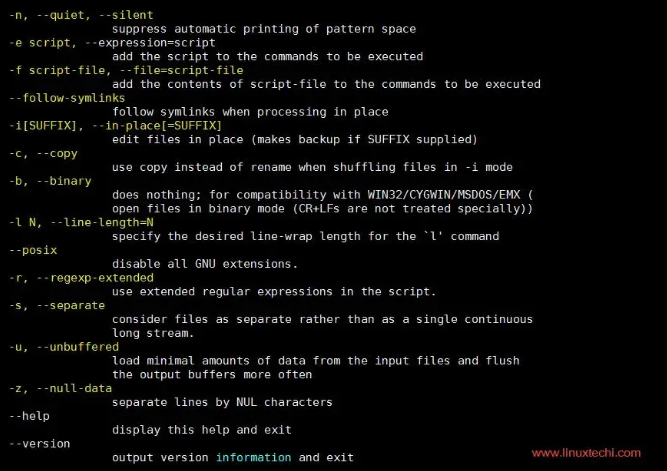

SED 命令或 流编辑器是 linux / Unix 系统提供的非常强大的实用程序。它主要用于文本替换,查找和替换,但也可以执行其他文本操作,例如 插入,删除,搜索 等。使用 SED,我们可以编辑完整的文件而无需打开它。SED 还支持使用正则表达式,这使得 SED 成为更强大的测试操作工具。
基本语法如下:
sed OPTIONS… [SCRIPT] [INPUTFILE…]

使用 sed,可以只查看文件的一部分,而不是查看整个文件,示例如下:
[linuxtechi@localhost ~]$ sed -n 22,29p testfile.txt
本例子,选项 n 将抑制整个文件的打印,选项 p 将只打印 22-29 行
使用选项 d,显示除 22-29 行之外的所有行
[linuxtechi@localhost ~]$ sed 22,29d testfile.txt
显示从第 2 行或任何其他行开始的每 3 行内容,使用以下命令
[linuxtechi@localhost ~]$ sed -n '2~3p' file.txt
其中 N 是行号,选项 d 将删除提到的行号,示例如下:
[linuxtechi@localhost ~]$ sed Nd testfile.txt
若要删除文件的最后一行,请使用如下命令:
[linuxtechi@localhost ~]$ sed $d testfile.txt
从 testfile.txt 文件中删除 29-34 行
[linuxtechi@localhost ~]$ sed '29,34d' testfile.txt
从 testfile.txt 文件中删除 29-34 之外的行
[linuxtechi@localhost ~]$ sed '29,34!d' testfile.txt
使用选项 G, 可以在每个非空行之后添加一个空行
[linuxtechi@localhost ~]$ sed G testfile.txt
使用 s 选项,将搜索 danger,并将其替换为 saftey,执行首次匹配。
[linuxtechi@localhost ~]$ sed 's/danger/safety/' testfile.txt
为了完全替换文件中的所以单词,我们将使用带有 s 的选项 g
[linuxtechi@localhost ~]$ sed 's/danger/safety/g' testfile.txt
还可以在第 n 次出现时替换字符串,比如只有在第二次出现时才用 danger 替换 safety,依然是首次替换模式
[linuxtechi@localhost ~]$ sed 's/danger/safety/2' testfile.txt
为了完全替换第 2 次出现的所有单词,我们将使用带有 s 的选项 g,完全替换模式
[linuxtechi@localhost ~]$ sed 's/danger/safety/2g' testfile.txt
只替换文件第 4 行的字符串
[linuxtechi@localhost ~]$ sed '4 s/danger/safety/' testfile.txt
替换文件第 4-9 行的字符串
[linuxtechi@localhost ~]$ sed '4,9 s/danger/safety/' testfile.txt
使用选项 a, 在每个模式匹配之后添加新行
[linuxtechi@localhost ~]$ sed '/danger/a "This is new line with text after match"' testfile.txt
使用选项 i, 在每个模式匹配之前添加新行
[linuxtechi@localhost ~]$ sed '/danger/i "This is new line with text before match" ' testfile.txt
使用 c 选项,当匹配时,正行都会被新内容替换,示例如下:
[linuxtechi@localhost ~]$ sed '/danger/c "This will be the new line" ' testfile.txt
到目前为止,我们只使用 sed 的简单表达式,现在我们将讨论 sed 与 regex 的一些高级用法
如果需要执行多个 sed 表达式,可以使用选项 e 将 sed 命令链接起来
[linuxtechi@localhost ~]$ sed -e 's/danger/safety/g' -e 's/hate/love/' testfile.txt
编辑之前创建文件的备份副本,请使用选项 -i.bak
[linuxtechi@localhost ~]$ sed -i.bak -e 's/danger/safety/g' testfile.txt
这将创建扩展名为.bak 的文件的备份副本,你也可以使用其他扩展,例如 -i.backup
删除以特定字符串开始并以另一个字符串结束的行,示例如下:
[linuxtechi@localhost ~]$ sed -e 's/^danger.*stops$//g' testfile.txt
使用 sed & regex 在每行之前添加一些内容,示例如下:
[linuxtechi@localhost ~]$ sed -e 's/.*/testing sed &/' testfile.txt
要删除所有注释行,即带有 # 和所有空行的行,使用如下命令
[linuxtechi@localhost ~]$ sed -e 's/#.*//;/^$/d' testfile.txt
只删除注释行,使用如下命令:
[linuxtechi@localhost ~]$ sed -e 's/#.*//' testfile.txt
要获取 /etc/passwd 文件的所有用户名列表,使用如下命令:
[linuxtechi@localhost ~]$ sed 's/([^:]*).*/1/' /etc/passwd
sed -i 命令已经被用来删除系统链接,并只创建常规文件来代替链接文件。因此,为了避免这种情况并防止 sed -i 破坏链接,请在执行命令时使用 follow-symklinks 选项。
假设我们想在 centos 或 RHEL 服务器上禁用 SELinux
[linuxtechi@localhost ~]# sed -i --follow-symlinks 's/SELINUX=enforcing/SELINUX=disabled/g' /etc/sysconfig/selinux